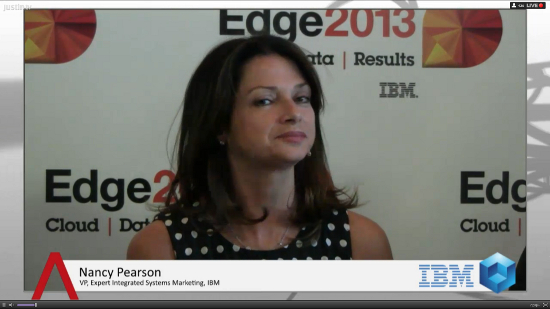 NEWS
NEWS
 NEWS
NEWS
 NEWS
NEWS
Nancy Pearson, VP Expert Integrated Systems Marketing, IBM, discussed the results of the department she runs and the ecosystem IBM is building with theCube co-hosts Dave Vellante and John Furrier, live at the IBM Edge 2013 conference.
“We’ve just had our first year anniversary,” she said, reporting they have sold over 4000 systems globally, and will continue to sell, and “get all kinds of exciting new customers and examples of success.” Pearson said that the company is still making progress on building up the ecosystems, aiming to keep adding more business patterns (which partners contribute to the ecosystem) and continue to produce new IBM patterns. By deploying these patterns you are able to accelerate results and the deployment of applications.
“A pattern really quantifies experience, knowledge, references,” architecture, from partners, a type of collective intelligence. “It takes our clients a tremendous amount of time to get the same knowledge and expertise on their own.” She also added that “it’s equally important that IBM is creating patterns from our own software and from third party software.” The numbers are growing and they will continue to grow.
Commenting on the company’s open source involvement, Pearson pointed out that “it’s what open source is what really about: everyone can contribute. The best ideas are the ones that flourish.”
Explaining what the ecosystem implies, Pearson mentioned a number of partners that sell / provide services and deliver our PureSystems to clients and work with them, ISVs, patterns, application focus, speed of deploying applications. Client and business partners’ investments are also part of it, and also a number of MSPs (managed service providers) “they love our peer systems because they’re interested in delivering services themselves.”
Commenting on customer requirements, she said “they don’t want to spend time perfecting the infrastructure for these applications, they want a consistent environment where they can deploy” without doing the work. The ecosystem offers “an easier environment to manage and it’s more consistent.”
The ecosystem addressed mid to large sized customers, MSPs where there’s a very quick adoption, a lot of enterprises, a wide variety of businesses and “a tremendous amount of cloud deployments.”
Commenting on the company’s projects on data management – disaster recovery, data protection, Pearson said: “We’ve just announced backup and backup recovery for PureFlex and Flex systems,” which “makes them a very solid environment for disaster recovery.”
“We talked about a number of reference architectures and we’ll be delivering around of patterns around SAP. We’ve just announced the capabilities for the business suite in Hanna. We’re talking about an SAP pattern for Pure applications,” she added.
The company’s clients try to deploy applications faster and more efficiently. Social, mobile, cloud, Big Data and analytics puts pressure on delivering capabilities faster. The ecosystem allows a more streamlined, simpler solution that is built for the cloud and can address this issues.
Asked how she explains this solution to customers, Pearson admitted “it’s kind of difficult to explain. It’s fine if you’re talking to progressive businesses, but out of that space they really think we’re in another land. I think everyone is clamoring for something that’s easier to manage and implement.” As a result, client companies are able to deploy applications faster, they are able to analyze Big Data faster, and reduce costs.
As far as future plans are concerned, Pearson mentioned more business solution support, keeping the very strong focus on cloud capabilities, and aiming for more successful clients. Commenting on Edge 2013, she said: “the thing that I am so impressed with is incredible leadership and the integrated story across IBM. The client stories have been outstanding.”